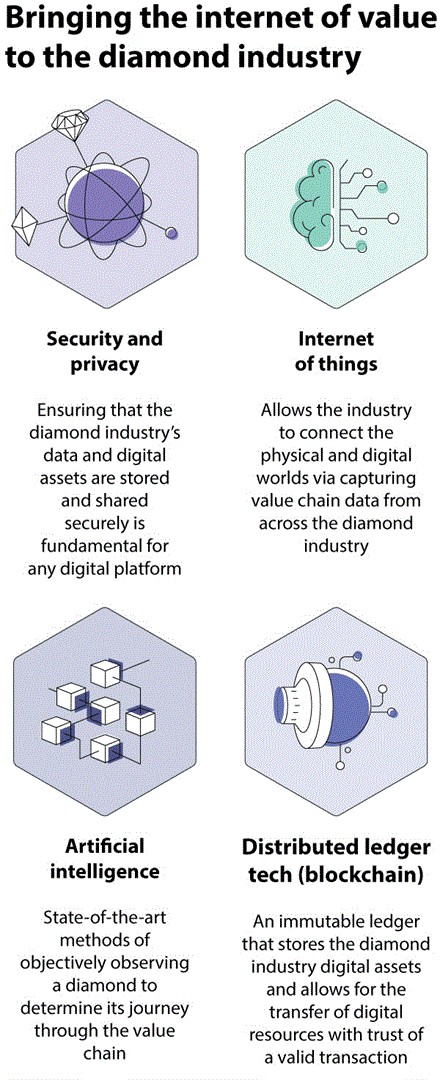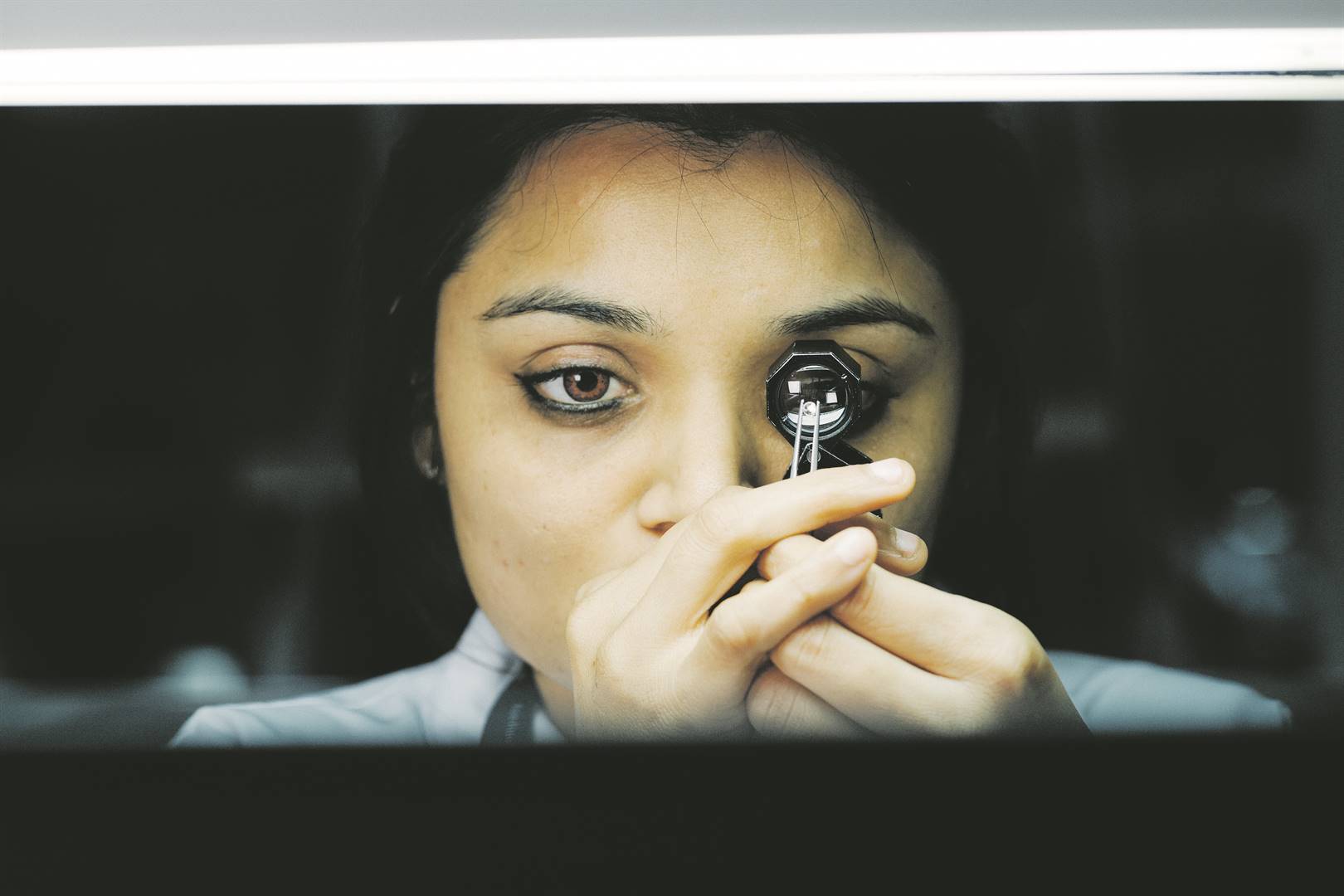
As South Africa celebrates a generation of freedom, Anglo American acknowledges its deep roots in the country and looks ahead to its contribution in the next 25 years and beyond.
Over the next five weeks experience 25 Reasons to Believe with City Press as we explore the economy, job creation, enterprise development, health, land reform, sustainability, education, technology and – most important of all – the communities
Diamonds may have been forged from heat and carbon millions of years ago, but these ancient gems will soon benefit from cutting-edge modern blockchain technology to reassure buyers that they are the real, ethically sourced deal.
An initiative by Anglo American’s diamond business, De Beers Group, is harnessing the possibilities of the fourth industrial revolution (4IR) to ensure that each authentic diamond produced has a permanent digital record that cannot be tampered with.
In an industry whose reputation has taken a knock from the twin phenomena of so-called blood diamonds and fake stones, this blockchain “fingerprint” will ensure that each party in the value chain will know the exact origin and provenance of the diamonds it processes, sells or buys. With the significant investment in diamonds in South Africa, ensuring their authenticity is paramount.
The new platform, called Tracr™, is the first to digitally track a diamond’s journey from mine to consumer. Having been successfully piloted by De Beers Group in collaboration with leading diamond producers, manufacturers and retailers, this revolutionary technology is being scaled up to meet the needs of all possible users. Once it is rolled out, it will be available to the entire diamond industry.
For the industry, by the industry
“It’s being designed by the industry, for the industry,” explains Feriel Zerouki, the De Beers Group’s senior vice-president of international relations and ethical initiatives. “We are very pleased with the progress and success of the pilot programme to date.”
The world now eagerly awaits the launch of this pioneering digital platform aimed at “creating a robust data-sharing ecosystem that responds to consumer requirements, while simultaneously driving better business efficiency” in the diamond industry.
Zerouki is excited about the technology that has given rise to this innovation, which may well have other mining-related applications.
“For each diamond, we create a unique digital asset that is a direct representation of its physical counterpart,” she explains. “The blockchain is where these digital assets are created, amended and secured, underpinning consumer confidence while also enhancing efficiency across the sector.”
Since the implementation of the Kimberley Process – an agreement that unites administrations, civil societies and industry in reducing the flow of conflict diamonds – and other initiatives such as the De Beers Group’s own best practice principles in 2005, the industry has made impressive strides in highlighting the importance of a responsible diamond supply chain.
GlobeScan research among thought leaders shows that the industry is widely respected for doing, or trying to do, the right thing by sourcing the gems responsibly.
Global demand for diamonds has remained strong and the industry has shown resilience in recent years. However, Zerouki says that some people still harbour niggling doubts about the gems.
“Through our research in the US last year, a small minority of consumers – 7% – told us that the reason they did not acquire diamond jewellery in the previous year was that they did not trust that the diamond jewellery sold in stores had been responsibly sourced. Elsewhere in the world, our research shows a negligible percentage of consumers with this view.”
It’s hoped that the introduction of Tracr™ as an additional integrity standard will go a long way towards allaying those fears by shoring up consumer confidence in diamonds. Zerouki points out that brands and retailers such as Forevermark and Tiffany are already providing guarantees of responsible sourcing and provenance, and that “Tracr™ will complement all of these efforts by giving an immutable digital record of the diamond’s journey”.
Tracr will not only give the lover of timeless jewellery an assurance of a diamond’s provenance, traceability and authenticity, it will benefit the whole diamond value chain “from large diamond producers to small family-owned businesses” by enabling them to communicate and trade more efficiently.
Plus, it will give the industry an ecosystem through which to build value-adding applications – much like the invention of the smartphone opened the door for multiple apps to be developed and launched.
However, it remains to be seen whether the costs of authenticating a diamond will be passed on to the end buyer.
“Tracr™ is a B2B platform, whereby we provide the infrastructure for the industry to efficiently communicate and trade,” says Zerouki. “It is for the industry to decide on the value of providing information on their diamonds’ credentials, be it ethical sourcing or expertise in craftsmanship.”
Tapping into the internet of value
This application of blockchain technology in the diamond industry is just the latest innovation to be delivered by Industry 4.0, powered by the Internet of Value, which relates to the digital transfer of anything with a monetary value. This marks an evolution from the Internet of Things (relating to connected devices that transmit data) that further blurs the line between the physical and digital worlds.
It’s a space in which physical assets of value can be represented digitally as data, and Zerouki says it holds great opportunities for companies to showcase their sustainability credentials in a transparent and reliable way.
A digital revolution is under way in diamond mining as technology is used to propel this classic gemstone into a smarter, more connected future.
A Bain & Company report released last year said that one of the main trends shaping the future of the global diamond industry was the increasing influence of digitisation.
“Emerging and maturing digital technologies are affecting all parts of the value chain, enabling diamond producers, midstream players and retailers to increase efficiencies within their operations. Marketing efforts that use digital technology can also deliver superior customer experiences,” it said.
The advent of Tracr™ bears out this prediction. But, Zerouki says, De Beers Group is not stopping at blockchain when harnessing technology to create a more sustainable mining future.
“For example, we are looking into the possibilities of carbon-neutral mining, which could be achieved through tapping into the potential of kimberlite, a diamond-bearing rock that captures carbon dioxide through a process known as mineral carbonation,” she says.
Whether it symbolises bling, elegance or an eternal bond, consumers will soon be able to rest assured that the exquisite diamond they are wearing has a history and guarantee embedded in its digital DNA. They’ll know that it’s natural, beautiful and conflict-free – and deserving of all the “oohs” and “aahs” it elicits.
- To find out more, visit the Tracr™community at tracr.com
WHAT IS BLOCKCHAIN?
Blockchain technology is a way of passing information from point A to point B in an automated, transparent and safe manner that cannot be tampered with.
According to Don and Alex Tapscott, the authors of the 2016 book Blockchain Revolution: “The blockchain is an incorruptible digital ledger of economic transactions that can be programmed to record not just financial transactions, but virtually everything of value.”
Simply put, a blockchain is a series of “blocks” of digital data carrying a time stamp, managed by a cluster of computers. Each block is secured to the other using a cryptographic “chain”.
According to Blockgeeks.com, because the blockchain is shared and cannot be altered or falsified, the information it holds is open for anyone to see, “hence, anything that is built on the blockchain is by its very nature transparent and everyone involved is accountable for their actions”.
In practice, when the Tracr™ blockchain technology is implemented, only ethically sourced and produced diamonds will be registered on the platform, giving a digital timeline or family tree of each stone’s journey from source to shop window.
BLOOD DIAMONDS
HOW FAR HAVE WE COME?
An ugly blot on the global diamond industry was highlighted by the release of the 2006 film Blood Diamond, starring Leonardo DiCaprio, which shone a spotlight on the problem of conflict diamonds, or “blood diamonds”.
According to the World Diamond Council, these are diamonds (usually rough and uncut) that are illegally traded in war-torn areas to fund armed conflict. Apart from the human cost of the lives lost in these civil wars, people are often subjected to slave-like conditions to extract these gems.
Growing awareness of this problem meant that diamonds – once the epitome of glamour and eternity thanks to the immortal tagline “a diamond is forever” – began losing their lustre, despite diamond producers’ assurances that their stones were ethically mined and that local communities shared in the wealth.
But even before the film’s release, the 2003 Kimberley Process brought together government, industry and civil society bodies to agree on a certification process for ethical diamond production. Eighty-two countries signed it into law, ensuring that 99.8% of the world’s diamonds now come from conflict-free sources.
The World Diamond Council also created the System of Warranties in 2002, which was updated last year. It outlines responsible business practices for the industry and ensures it adheres to ethical human rights practices.
Zerouki says: “Once the risk was identified, proactive collaboration within the industry helped protect diamond equity, and encouraged industry players like ourselves to continue to do more and invest in initiatives that support transparency – because we have a great story to tell!”




 Publications
Publications
 Partners
Partners










